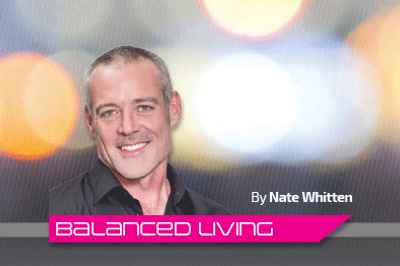By Nate Whitten, August 2015 Issue.
According to magazines, social apps and porn sites, every gay guy’s appearance includes six-pack abs, a high and tight bubble butt and a well-endowed package.
As we all know, that is not the reality. Don’t believe me? Take notice the next time you’re meandering around the local gay bar.
The truth is that things are not always as they appear.
Similarly, there’s a lot of polarization – politically, socially, culturally, physically and spiritually – going on within our country, our state and even our community. It appears as though everyone has a stance on either the far left or the far right, and there appears to be a lack of acceptance – not tolerance – for the experiences and opinions that differ from our own.
1. Different strokes for different folks.
Most often, people of all shapes and sizes make diet and exercise decisions to achieve one of two outcomes: To make changes or to maintain.
Those looking to maintain their current health stats and body type, typically choose some form of physical activity and nutritional standard that works for their specifically tailored goal. People with these goals are much different than those on strict regimens of diet and exercise with the intent of shaping and defining their body into their desired form (and that’s none of your business, is it?).
Is one of these approaches better than the other? Of course not. Each has a purpose. Bodybuilders are in a competition mindset – some compete for titles, others are competing for attention. And even others are competing with themselves to see what they can achieve. Making comparisons between these two types of people seen at the gym is also making assumptions that everyone’s priorities and goals should be the same. But they aren’t. And that’s OK.
2. Don’t ASS-U-ME.
A person carrying excess fat will have a fatty liver. This is unhealthy for many reasons. But that condescending, muscle boy with a never-ending bar tab could just as easily be working his way toward severe liver disease. Which is better? Which is worse?
Think of it like this: You hook up with a “straight-acting” masculine bro from Grindr. You get to his house, and into the bedroom, when you realize you can’t get his feet off the ceiling. In the same way, you can’t assume that just because a person looks healthy, that they really are. And you can’t assume that someone with excess weight is less healthy than someone else.
3. A “type” is a personal preference, not a personal rejection.
Some people are more attracted to bears. Some are attracted to twinks. So, when your man crush isn’t interested in your body, it doesn’t mean they aren’t interested in you as a person. It just means they can’t see going to bed with you every night for the rest of their lives – or maybe even just tonight.
Just because you aren’t someone’s type doesn’t necessarily mean it has to be a total rejection. It may not be a rejection at all. They could be saving you from a potential relationship that would eventually become only one-sided and unfulfilling to both of you. I know that makes them seem even more attractive because they have such a good heart. But EVERYONE has a type. Some are based on image, some are based on emotional stability/instability, some are based on age and others based on financial or social status. You’re body type, whether big or little doesn’t have to define your relationships, if you don’t want it to.
4. Everyone is vain.
Without vanity, we wouldn’t even be able to compare ourselves to anyone else and either accept or reject what we perceive. There has to be a base line to measure from, and it’s our vanity and ego. Healthy or not, this give us this ability to make judgments based on our differences.
Acknowledging that, until you know the whole story and the whole person, you could choose to let go of any biases you may be holding to. One type is not better than the other, just different. One person is not better than the other, just different.
